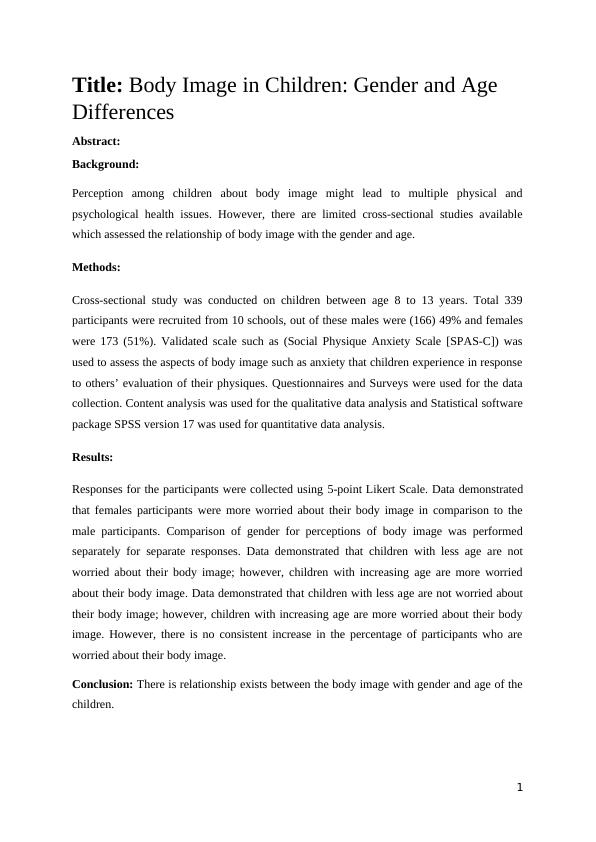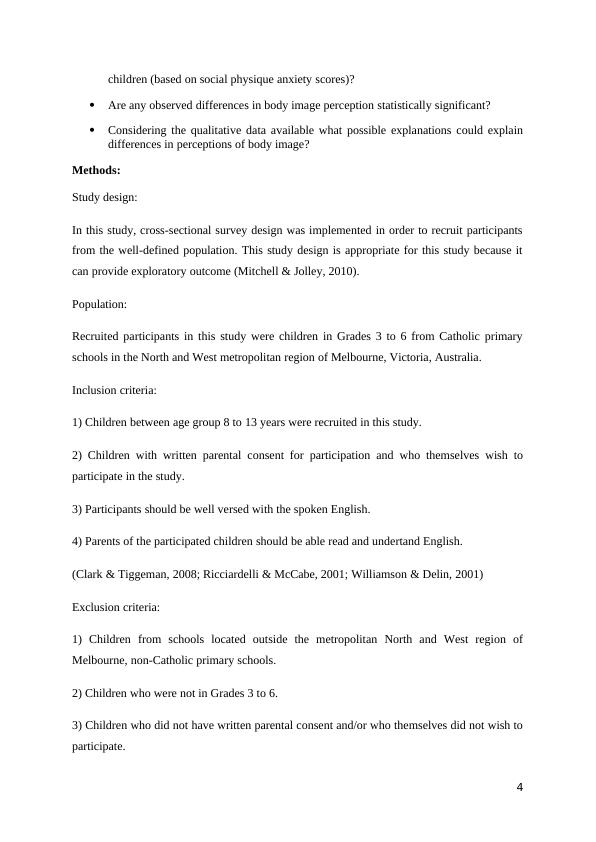Body Image in Children: Gender and Age Differences
Added on 2022-11-22
15 Pages4201 Words401 Views
Title: Body Image in Children: Gender and Age
Differences
Abstract:
Background:
Perception among children about body image might lead to multiple physical and
psychological health issues. However, there are limited cross-sectional studies available
which assessed the relationship of body image with the gender and age.
Methods:
Cross-sectional study was conducted on children between age 8 to 13 years. Total 339
participants were recruited from 10 schools, out of these males were (166) 49% and females
were 173 (51%). Validated scale such as (Social Physique Anxiety Scale [SPAS-C]) was
used to assess the aspects of body image such as anxiety that children experience in response
to others’ evaluation of their physiques. Questionnaires and Surveys were used for the data
collection. Content analysis was used for the qualitative data analysis and Statistical software
package SPSS version 17 was used for quantitative data analysis.
Results:
Responses for the participants were collected using 5-point Likert Scale. Data demonstrated
that females participants were more worried about their body image in comparison to the
male participants. Comparison of gender for perceptions of body image was performed
separately for separate responses. Data demonstrated that children with less age are not
worried about their body image; however, children with increasing age are more worried
about their body image. Data demonstrated that children with less age are not worried about
their body image; however, children with increasing age are more worried about their body
image. However, there is no consistent increase in the percentage of participants who are
worried about their body image.
Conclusion: There is relationship exists between the body image with gender and age of the
children.
1
Differences
Abstract:
Background:
Perception among children about body image might lead to multiple physical and
psychological health issues. However, there are limited cross-sectional studies available
which assessed the relationship of body image with the gender and age.
Methods:
Cross-sectional study was conducted on children between age 8 to 13 years. Total 339
participants were recruited from 10 schools, out of these males were (166) 49% and females
were 173 (51%). Validated scale such as (Social Physique Anxiety Scale [SPAS-C]) was
used to assess the aspects of body image such as anxiety that children experience in response
to others’ evaluation of their physiques. Questionnaires and Surveys were used for the data
collection. Content analysis was used for the qualitative data analysis and Statistical software
package SPSS version 17 was used for quantitative data analysis.
Results:
Responses for the participants were collected using 5-point Likert Scale. Data demonstrated
that females participants were more worried about their body image in comparison to the
male participants. Comparison of gender for perceptions of body image was performed
separately for separate responses. Data demonstrated that children with less age are not
worried about their body image; however, children with increasing age are more worried
about their body image. Data demonstrated that children with less age are not worried about
their body image; however, children with increasing age are more worried about their body
image. However, there is no consistent increase in the percentage of participants who are
worried about their body image.
Conclusion: There is relationship exists between the body image with gender and age of the
children.
1

Index:
Introduction 3
Methods 4
Results 5
Discussion 11
Reference 13
Appendix 15
2
Introduction 3
Methods 4
Results 5
Discussion 11
Reference 13
Appendix 15
2

Introduction:
It is evident that body image can affect both physical and psychological health of an
individual. Individuals with negative perception about body image often demonstrate
behaviour like social avoidance, inappropriate dietary practices and compulsive exercise.
These types of behaviours can result in different health related issues such as eating
disorders, depression, obesity and reduced self-esteem and dignity (Grogan, 2006; Littleton &
Ollendick, 2003; Stice, Hayward, Cameron, Killen, & Taylor, 2000).
Body image perception among young population has been studied extensively however; three
dimensions such as muscularity; social physique anxiety; and body esteem were not studied
in detailed manner. There is scarcity of evidence-based information about the desire of young
population for muscularity. Muscularity measurement is important aspect in cases of young
males because it is related to multiple health issues. Hence, it is necessity to carry out
research on desire of children to increase muscularity (Cafri & Thompson, 2004; Pope,
Phillips, & Olivardia, 2000; Ricciardelli, McCabe, Mussap, & Holt, 2009).
Social physique anxiety is the variant of anxiety which is not studied in detail. Studies
demonstrated that social physique anxiety in adults lead to altered exercise behaviour in the
children which can both discourage and promote participation in the sports (Hart, Leary, &
Rejeski, 1989). However, implication of social physique anxiety in children is not well
studied. Moreover, it is evident that social physique activity lead to unhealthy behaviour in
children which can result in negative health consequences. Hence, it is essential to study
social physique anxiety in children to prevent health and behaviour in children (Hart, Leary,
& Rejeski, 1989).
Body esteem which comprises of attitudes, evaluations and feelings of a person in relation to
their body image is not well studied. Body image also lead to unhealthy behaviour in
children. However, there is scarcity of research related to evaluation of body esteem in
children. Moreover, there is scarcity of research examining difference between gender and
age in perception of body image (Gardner, Friedman, & Jackson, 1999).
Hence, it is necessary to conduct research about body image related to muscularity, social
physique anxiety and body esteem in children.
Research questions:
How do perceptions of body image vary by age and gender for pre-adolescent
3
It is evident that body image can affect both physical and psychological health of an
individual. Individuals with negative perception about body image often demonstrate
behaviour like social avoidance, inappropriate dietary practices and compulsive exercise.
These types of behaviours can result in different health related issues such as eating
disorders, depression, obesity and reduced self-esteem and dignity (Grogan, 2006; Littleton &
Ollendick, 2003; Stice, Hayward, Cameron, Killen, & Taylor, 2000).
Body image perception among young population has been studied extensively however; three
dimensions such as muscularity; social physique anxiety; and body esteem were not studied
in detailed manner. There is scarcity of evidence-based information about the desire of young
population for muscularity. Muscularity measurement is important aspect in cases of young
males because it is related to multiple health issues. Hence, it is necessity to carry out
research on desire of children to increase muscularity (Cafri & Thompson, 2004; Pope,
Phillips, & Olivardia, 2000; Ricciardelli, McCabe, Mussap, & Holt, 2009).
Social physique anxiety is the variant of anxiety which is not studied in detail. Studies
demonstrated that social physique anxiety in adults lead to altered exercise behaviour in the
children which can both discourage and promote participation in the sports (Hart, Leary, &
Rejeski, 1989). However, implication of social physique anxiety in children is not well
studied. Moreover, it is evident that social physique activity lead to unhealthy behaviour in
children which can result in negative health consequences. Hence, it is essential to study
social physique anxiety in children to prevent health and behaviour in children (Hart, Leary,
& Rejeski, 1989).
Body esteem which comprises of attitudes, evaluations and feelings of a person in relation to
their body image is not well studied. Body image also lead to unhealthy behaviour in
children. However, there is scarcity of research related to evaluation of body esteem in
children. Moreover, there is scarcity of research examining difference between gender and
age in perception of body image (Gardner, Friedman, & Jackson, 1999).
Hence, it is necessary to conduct research about body image related to muscularity, social
physique anxiety and body esteem in children.
Research questions:
How do perceptions of body image vary by age and gender for pre-adolescent
3

children (based on social physique anxiety scores)?
Are any observed differences in body image perception statistically significant?
Considering the qualitative data available what possible explanations could explain
differences in perceptions of body image?
Methods:
Study design:
In this study, cross-sectional survey design was implemented in order to recruit participants
from the well-defined population. This study design is appropriate for this study because it
can provide exploratory outcome (Mitchell & Jolley, 2010).
Population:
Recruited participants in this study were children in Grades 3 to 6 from Catholic primary
schools in the North and West metropolitan region of Melbourne, Victoria, Australia.
Inclusion criteria:
1) Children between age group 8 to 13 years were recruited in this study.
2) Children with written parental consent for participation and who themselves wish to
participate in the study.
3) Participants should be well versed with the spoken English.
4) Parents of the participated children should be able read and undertand English.
(Clark & Tiggeman, 2008; Ricciardelli & McCabe, 2001; Williamson & Delin, 2001)
Exclusion criteria:
1) Children from schools located outside the metropolitan North and West region of
Melbourne, non-Catholic primary schools.
2) Children who were not in Grades 3 to 6.
3) Children who did not have written parental consent and/or who themselves did not wish to
participate.
4
Are any observed differences in body image perception statistically significant?
Considering the qualitative data available what possible explanations could explain
differences in perceptions of body image?
Methods:
Study design:
In this study, cross-sectional survey design was implemented in order to recruit participants
from the well-defined population. This study design is appropriate for this study because it
can provide exploratory outcome (Mitchell & Jolley, 2010).
Population:
Recruited participants in this study were children in Grades 3 to 6 from Catholic primary
schools in the North and West metropolitan region of Melbourne, Victoria, Australia.
Inclusion criteria:
1) Children between age group 8 to 13 years were recruited in this study.
2) Children with written parental consent for participation and who themselves wish to
participate in the study.
3) Participants should be well versed with the spoken English.
4) Parents of the participated children should be able read and undertand English.
(Clark & Tiggeman, 2008; Ricciardelli & McCabe, 2001; Williamson & Delin, 2001)
Exclusion criteria:
1) Children from schools located outside the metropolitan North and West region of
Melbourne, non-Catholic primary schools.
2) Children who were not in Grades 3 to 6.
3) Children who did not have written parental consent and/or who themselves did not wish to
participate.
4

End of preview
Want to access all the pages? Upload your documents or become a member.
Related Documents
Self Efficacy and Gender Studylg...
|20
|4663
|216
Race Diversity and Discrimination in School: Impact on Child's Behaviorlg...
|4
|623
|261
Relationship of Smartphone Use Severity with Sleep Quality, Depression and Anxiety in University Students: A Critical Reviewlg...
|7
|1835
|192
Medical Journal of Australia Manuscript submission template.lg...
|9
|2819
|72
Healthcare WHO Assignment 2022lg...
|10
|2190
|26
Adolescence Developmental Stage and Importance of Biological and Social Influencelg...
|10
|2584
|96